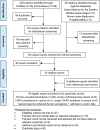Urban Chikungunya in the Middle East and North Africa: A systematic review
- PMID: 28651007
- PMCID: PMC5501693
- DOI: 10.1371/journal.pntd.0005707
Urban Chikungunya in the Middle East and North Africa: A systematic review
Abstract
Background: The epidemiology of Chikungunya virus (CHIKV) in the Middle East and North Africa (MENA) is not well characterized despite increasing recognition of its expanding infection and disease burden in recent years.
Methodology / principal findings: Following Cochrane Collaboration guidelines and reporting our findings following PRISMA guidelines, we systematically reviewed records describing the human prevalence and incidence, CHIKV prevalence/infection rates in vectors, outbreaks, and reported cases for CHIKV across the MENA region. We identified 29 human seroprevalence measures, one human incidence study, one study reporting CHIKV infection rates in Aedes, and nine outbreaks and case reports/series reported in the MENA from 1970-2015. Overall, anti-CHIKV antibody or reports of autochthonous transmission were identified from 10 of 23 countries in the MENA region (Djibouti, Egypt, Iraq, Iran, Kuwait, Pakistan, Saudi Arabia, Somalia, Sudan, and Yemen), with seroprevalence measures among general populations (median 1.0%, range 0-43%) and acute febrile illness populations (median 9.8%, range 0-30%). Sudan reported the highest number of studies (n = 11) and the highest seroprevalence among general populations (median 12%, range 0-43%) and undifferentiated acute febrile illness populations (median 18%, range 10-23%). CHIKV outbreaks were reported from Djibouti, Pakistan, Sudan, and Yemen.
Conclusions / significance: Seroprevalence studies and outbreak reports suggest endemic transmission of urban cycle CHIKV in at least the Red Sea region and Pakistan. However, indications of seroprevalence despite a low quantity of CHIKV epidemiologic research from the region suggests that CHIKV transmission is currently underrecognized.
Conflict of interest statement
The authors have declared that no competing interests exist.
Figures
Similar articles
-
Dengue in the Middle East and North Africa: A Systematic Review.PLoS Negl Trop Dis. 2016 Dec 7;10(12):e0005194. doi: 10.1371/journal.pntd.0005194. eCollection 2016 Dec. PLoS Negl Trop Dis. 2016. PMID: 27926925 Free PMC article.
-
Evidence of previous but not current transmission of chikungunya virus in southern and central Vietnam: Results from a systematic review and a seroprevalence study in four locations.PLoS Negl Trop Dis. 2018 Feb 9;12(2):e0006246. doi: 10.1371/journal.pntd.0006246. eCollection 2018 Feb. PLoS Negl Trop Dis. 2018. PMID: 29425199 Free PMC article.
-
The burden of Hepatitis E virus in the Middle East and North Africa region: a systematic review.J Infect Dev Ctries. 2022 May 30;16(5):737-744. doi: 10.3855/jidc.15701. J Infect Dev Ctries. 2022. PMID: 35656942
-
Socioeconomic indicators are strong predictors of hepatitis A seroprevalence rates in the Middle East and North Africa.J Infect Public Health. 2017 Sep-Oct;10(5):513-517. doi: 10.1016/j.jiph.2016.09.020. Epub 2017 Feb 2. J Infect Public Health. 2017. PMID: 28162965
-
Cryptic circulation of chikungunya virus in São Jose do Rio Preto, Brazil, 2015-2019.PLoS Negl Trop Dis. 2024 Mar 14;18(3):e0012013. doi: 10.1371/journal.pntd.0012013. eCollection 2024 Mar. PLoS Negl Trop Dis. 2024. PMID: 38484018 Free PMC article.
Cited by
-
Prevalence Pattern of Chikungunya Virus Infection in Nigeria: A Four Decade Systematic Review and Meta-analysis.Pathog Glob Health. 2020 May;114(3):111-116. doi: 10.1080/20477724.2020.1743087. Epub 2020 Mar 19. Pathog Glob Health. 2020. PMID: 32191166 Free PMC article.
-
Chikungunya virus in Asia - Pacific: a systematic review.Emerg Microbes Infect. 2019;8(1):70-79. doi: 10.1080/22221751.2018.1559708. Emerg Microbes Infect. 2019. PMID: 30866761 Free PMC article.
-
First comprehensive analysis of Aedes aegypti bionomics during an arbovirus outbreak in west Africa: Dengue in Ouagadougou, Burkina Faso, 2016-2017.PLoS Negl Trop Dis. 2022 Jul 6;16(7):e0010059. doi: 10.1371/journal.pntd.0010059. eCollection 2022 Jul. PLoS Negl Trop Dis. 2022. PMID: 35793379 Free PMC article.
-
Seroepidemiology of dengue and chikungunya fever in patients with rash and fever in Iran, 2017.Epidemiol Infect. 2020 Feb 26;148:e42. doi: 10.1017/S0950268820000114. Epidemiol Infect. 2020. PMID: 32100659 Free PMC article.
-
Molecular Epidemiology, Evolution and Reemergence of Chikungunya Virus in South Asia.Front Microbiol. 2021 Jun 7;12:689979. doi: 10.3389/fmicb.2021.689979. eCollection 2021. Front Microbiol. 2021. PMID: 34163459 Free PMC article. Review.
References
-
- Robinson MC. An epidemic of virus disease in Southern Province, Tanganyika Territory, in 1952–53. I. Clinical features. Trans R Soc Trop Med Hyg. 1955;49(1):28–32. . - PubMed
-
- World Health Organization. Chikungunya Fact Sheet. Available from: http://www.who.int/mediacentre/factsheets/fs327/en/. Accessed 29 Jan 2016.
Publication types
MeSH terms
Grants and funding
LinkOut - more resources
Full Text Sources
Other Literature Sources
Medical
Research Materials



